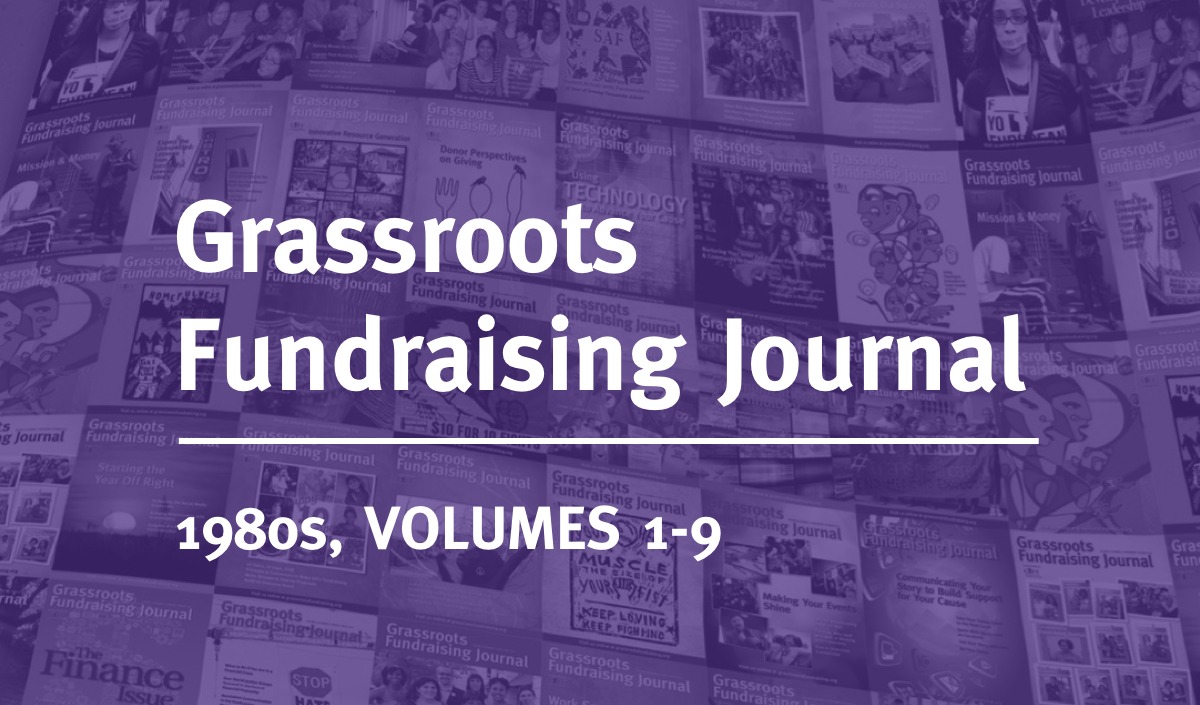
Editors’ note: This article, first published in print during April-2000, has been republished for Nonprofit Quarterly with minor updates.
As most Journal readers know, 82% of money given away by individuals in the United States comes from families with incomes of $60,000 or less. The donor profiled here is part of that 82%, and is therefore typical of the millions of people in the United States who give money away. She is a donor to a variety of organizations, including some that subscribe to the Grassroots Fundraising Journal, but does not come from a family with a tradition of giving, and has never included “donor” as part of how she thinks of her identity.
The donor is a Japanese-American, single woman in her mid-thirties living in a major metropolitan area. She is self-employed as a massage therapist, and lives in a rented apartment with two roommates. She earns between $24,000 and $28,000 a year and lives in a community with a very high cost of living, but her living expenses are reasonable because of her shared housing situation.
While this donor has been involved as a member or volunteer with a handful of community organizations for many years, it is only recently that she began to think more consciously and proactively about her financial support of organizations she believes in.
Her thinking and behavior started to change last year after she attended a weeklong meditation retreat. She began to think about her life goals and things she wanted to change in her life. One area that she gave a lot of thought to was how she spent her money. She also thought a lot about the state of the world and her feeling that she wasn’t doing as much as she could to make a difference.
Sign up for our free newsletters
Subscribe to NPQ's newsletters to have our top stories delivered directly to your inbox.
By signing up, you agree to our privacy policy and terms of use, and to receive messages from NPQ and our partners.
She decided that she wanted to make some changes in the way she spent her time and her money. She made a conscious decision to live more simply and to make more deliberate decisions about her use of money. She pointed out that this decision does not make her feel deprived in any way. She has enough to live on, is able to take vacations, but has shifted some priorities to be able to give away more money.
Many organizations overlook individuals with a demographic profile like our donor’s, assuming such a person couldn’t afford to give a major gift and thus wouldn’t be worth contacting personally. What’s important to note here is that the values that led this donor to want a simple lifestyle are the same values that make her a good and thoughtful donor.
Starting last year, she decided to give away 10% of her income. However, she does not receive any tax advantages for her giving, because she files a short form with the IRS. In fact, 71% of Americans do not receive a tax advantage for their giving for the same reason. There are clearly many other motivations for giving, as the amount of money given away each year in the U.S. continues to rise.
When this donor began looking for organizations to support, she turned to friends who work in nonprofits for information on who was doing what on particular issues. She felt she could get the most reliable recommendations from people who had hands-on experience and friends who had worked with a number of organizations in their community. The donor ultimately chose organizations that reflected her interests and commitment to environmental justice, women’s rights, reproductive rights, and international relief based in large part on suggestions from her trusted friends. She now typically gives between $50 and $200 as a single gift.
This donor does not generally respond to direct mail appeals, unless the appeal comes from a group she already knows. She prefers not to receive phone solicitations. No organization has ever asked her for a personal meeting, and she isn’t sure how she would respond to such a request. She did remember, however, a group that called to thank her for a recent gift. She felt that was a nice touch — a welcome change from the more typical call to ask for money.
This donor’s way of finding out about groups she wants to support—by talking to people she knows and trusts who work with nonprofits—highlights the importance of personal relationships in identifying new donors. Developing such relationships requires getting as many people as possible who are affiliated with an organization thinking about who might be interested in its work. It requires letting staff, board members, volunteers, members and donors know how important it is to talk about the organization to folks they know. Creating “buzz” about the work they’re doing, and then asking for support, will lead to more people willing to give it. Too often groups only think about personal solicitation in terms of very large gifts and leave the rest of their fundraising to impersonal acquisition strategies such as direct mail. By doing that, they leave out donors like this one—willing to give $100–$200 to a group if they came with a personal recommendation.







